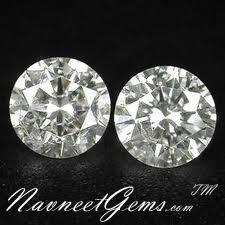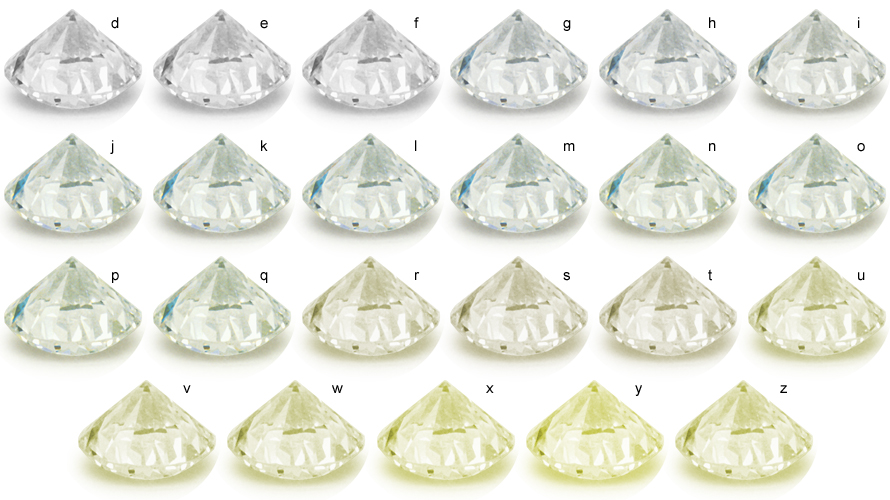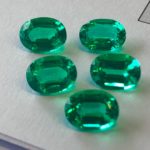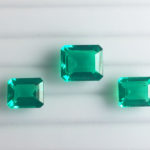Evaluating Gem Diamonds
The value of a gem diamond depends on several factors: size, color, clarity, cutting quality, and correct proportions.
Large diamonds are rarer than small ones, and therefore more valuable. The price of a diamond does not go up in simple steps along with size, however. A three-carat gem will cost far more, per carat, than three times that of a one-carat stone of comparable quality. In the past slowly decreasing, and the typical gem crystal found is becoming smaller and smaller. This creates a much higher premium on larger stones. Fashion does have some effect on prices. Dealers find that in some years gems between ½ and one carat are in greatest demand and large stones do not sell quickly. In other years the reverse may be true.
Color is the most important single factor that contributes to the value of a gem diamond. Several grading scales are currently in use; on the GIA scale, for example, the highest-quality color grades are D, E, and F, all corresponding to a pure “white” color, with no tinge of yellow. Further along in the scale, corresponding to moving through the alphabet to N, O, and p, a diamond would have an increasingly yellowish tint, and its value would drop steadily, all other factors being constant. If the yellow became very strong and attractive the diamond might, however, be considered a “fancy color,” and its value would be much higher than that of a so-called “off-color” stone.
To the untrained eye. Two gems may both appear “white,” whereas one might actually be F and the other J on the GIA scale, and the price difference could be as much as 3 percent. Color grading can only be done accurately by comparing a stone with a “master set” of graded gems of the same general size. The diamonds should be examined through the back, on a white background, and with a standard illumination. Obviously, grading is not a simple matter, and should always be done by someone trained in the techniques. The lighting is especially critical, and the best illumination for diamond grading is a filtered, cool-white, fluorescent lamp.
Clarity refers to the presence of inclusions, spots, or flaws in a gem. Most gemstones contain inclusions of other minerals, which were incorporated at the time of crystal growth. Inclusions decrease the value of a diamond. Their size and number can be determined using a magnifying glass or microscope.
In the past, the term “perfect” has been widely used in the gem trade to indicate a flawless diamond. The term “perfect” is a poor one and should be completely abandoned. The Federal Trade Commission regards a “flawless” diamond that contains no “flaws, cracks, carbon spots, clouds, or other blemishes or imperfections of any sort” when examined at a magnification of 10x by a trained eye.
A useful system of clarity grading has been devised by the Gemological Institute of America. It assesses diamonds according to the size, location, and several inclusions and blemishes present. Gems containing no such imperfections are considered flawless (F). With increasing size and number of imperfections, the classifications are very very slightly imperfect (VVSI), very slightly imperfect (VSI), slightly imperfect (SI), and imperfect (I). Each of these categories has two subdivisions, labeled 1 and 2 as subscripts. Some inclusions may be so small that they are not readily visible to the naked eye, and don’t materially affect the appearance of a cut gem.
However, their presence does materially affect the diamond’s value. Truly flawless diamonds are exceedingly scarce and very expensive. Sometimes imperfections near the girdle of a diamond are hidden by the setting. In addition, the true color of a set diamond cannot be determined. For these reasons, diamond grading can only be accomplished with unset stones.
The surface finish and polish of a diamond, as well as its proportions, affect its beauty and hence its value. As mentioned earlier, maximum brilliance and maximum dispersion cannot be achieved in a single stone with one set of angles and proportions. The ideal case would be a compromise, involving proportions and angles that would give brilliance and also substantial dispersive color. Some diamonds are cut to these dimensions, and such gems are indeed spectacular and beautiful. But most of the diamonds sold commercially do not have “ideal” proportions. This is because an acceptable appearance can be achieved with less stringent requirements, but at the same time, the cutter can produce larger stones from his rough material.
While “Diamonds are Forever” is a line that has transcended the ages, the narrative is changing to suit a wider demographic. The modern bride is no longer just looking for a conventional blinding sparkle but wants to invest more thoughtfully into a stone that has been ethically sourced while having a unique personality of its own.
Diamond is one of the loveliest of all gems. Its hardness is superior to that of any other stone, and its optical properties are unique among natural gems. Good marketing has created for the diamond an aura of extravagance and glamour.
Here, you can check out our latest collection of salt and pepper diamonds:https://www.navneetgems.com/salt-and-pepper-diamonds/
View this post on Instagram
Diamond, long a symbol of wealth and power, has been synthesized in the laboratory. To date, only a few crystals of a size suitable for gem use (up to one carat) HAVE BEEN GROWN. These were so expensive to manufacture, however, that at present they cannot compete with natural diamonds in the gem market.
Diamond is one of the loveliest of all gems. Its hardness is superior to that of any other stone, and its optical properties are unique among natural gems. Good marketing has created for the diamond an aura of extravagance and glamour. Yet tight international control of the diamond-marketing structure has meant price stability and solidity that benefits the entire jewelry industry.
Consumer Tips-The purchase of a diamond can be a major investment or mark an event of great personal significance, such as a marriage or engagement. Pitfalls include misuse by the seller of certain misleading terms, such as “perfect,” or “blue-white.” The FTC has established trade practice rules for the jewelry industry that prohibit the use of such terms except in rigorous circumstances. Rapid sight estimates of quality are untrustworthy, even from an expert. A stone should be graded under proper circumstances, with the right equipment, and this can best be done with unset gems.
The wholesale value of a correctly typical description of a diamond might read as follows: “Size 1.24 carat, color J, SI2, indicates the presence of several inclusions and blemishes. These factors would mean that the value of the diamond is not as great as that of a flawless, white, perfectly proportioned gem weighing 1.24 carat, by comparison. The stone in question might be worth only 35 percent as much. The exact percentage is determined by the exact color and clarity grade.




